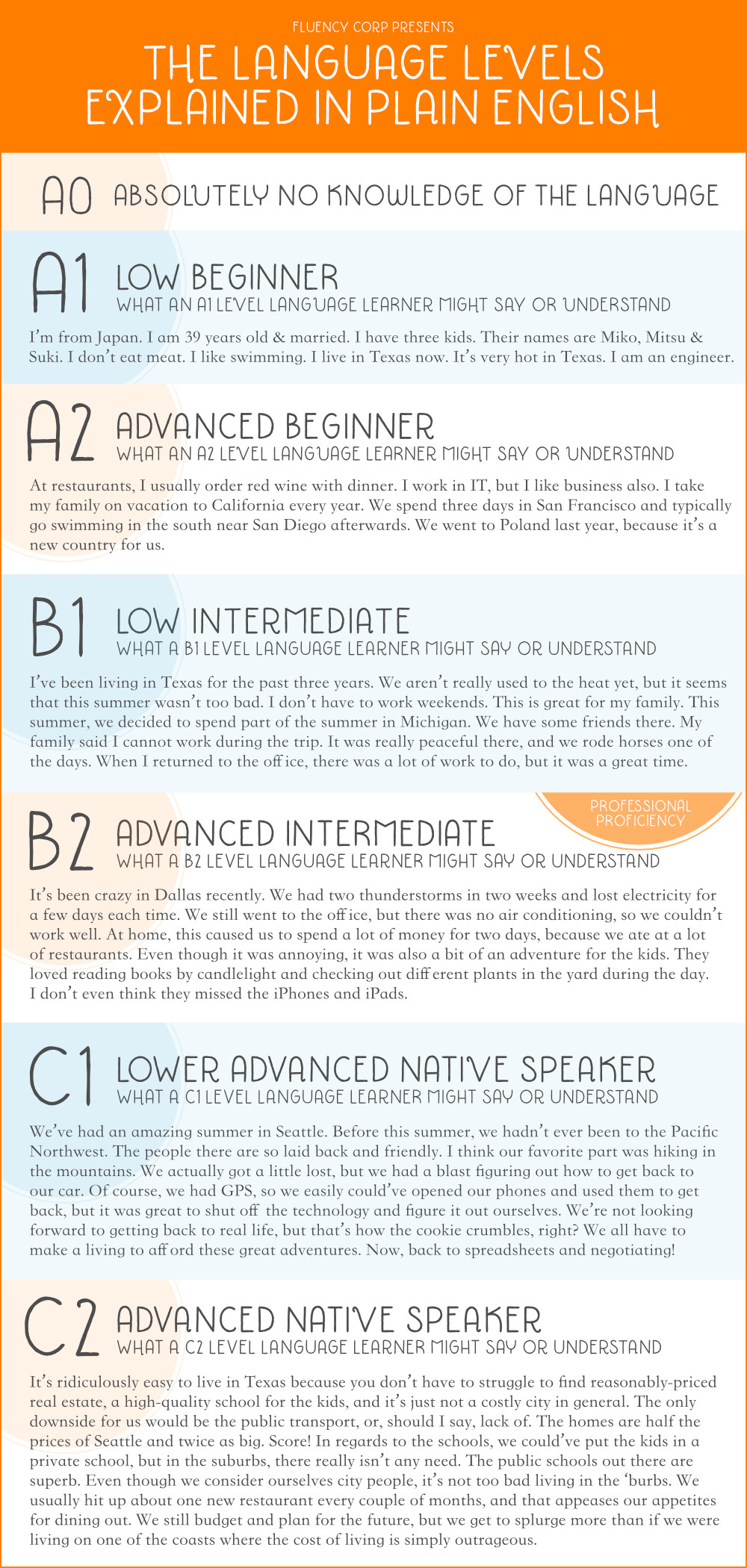At the beginning of any language course, a common first question from the student is, ‘What’s my level?”
Since we’ve been teaching and assessing students for the past 12 years, we can guess, correctly, a student’s language level within 5-10 minutes of speaking with him or her. But many times they, or their bosses, want an official test to see where they are so that they can then take the test again after the course.
While it is completely understandable that a corporation paying for its employees’ English lessons wants to know the level before and after a course, it is unlikely that they will see a difference on some of the more popular tests, especially if the student hasn’t prepared specifically for that test.
Getting from one language level to the next typically takes 250 hours or more, and most corporations buy 100 hours or less, but there are ways to assess the success of your English language program.
Language Proficiency Tests
If you or your organization is interested in language testing, there are quite a few language tests available: ACTFL, DELE (for Spanish), DALF (for French), TOEFL (for those going into English-speaking college, take this to prove your English level) and TOEIC (for those going into an English-speaking job position, take this to prove your high level of fluency in a competitive global job market).
But each one will test for a specific set of skills. So you can take an English course for the skills you need for your job, or you can prepare for the test, and learn things that might not be applicable to your work and life.
The predicament with each of these is that you might get a different result with each one of them. So if you’re going to see if you’ve improved, take the same test again at the end of your course, so you can compare apples with apples.
Which Language Level Reference Should I Use?
When people ask what language level they have, we use the CEFR levels put in place by the Council of Europe in the 1980s and 1990s to describe the various levels of speaking a foreign language.
It goes from A0 (no knowledge of the foreign language) up to C2 (Upper Advanced ability to speak a foreign language). This reference is used primarily in Europe, but many other countries are now using it as well.
In the United States, many organizations use the ACTFL, but no matter which reference you choose, you can see what your level is in any of the scales by checking out this chart.
As you can see, the ACTFL breaks down many of the CEFR levels into 3 different levels, as each CEFR level is a very big difference in terms of language proficiency. ACTFL does a good job of showing you where you lie in each CEFR level, and we speak more about this below.
There are also charts mapping your TOIEC and TOEFL levels compared to CEFR, which is very helpful to know what your level would be compared across all tests.
How Different is Each CEFR Level?
The levels between A0 and C2 are quite distinct, meaning that two students who are both considered B1 could have very different abilities in the language.
Researchers show various lengths of time to express how long it takes to get from the B1 level to the B2 level; most show that it can take up to 260 hours of exposure, learning, and/or usage in the language. So someone who has just come into the B1 level could take 260 hours just to get out of it.
Researchers also talk a lot about how these hours must be spent in order to consider them “Hours of Language Learning.” Here at Fluency Corp, we express these hours as “Time With the Language.”
But more weight must be given to active participation with the language (where the brain is pushing to express thoughts), and less weight given to passive activities (like reading a book, which does not give ear training).
For example, if you and a friend are talking for one hour, with constant back and forth, this is considered one hour toward your 260-hour goal to get from B1 to B2 level. If you read a book for one hour, this would only be considered 30 minutes toward true language proficiency.
You are possibly taking in syntax, grammar, and new vocabulary, but you are not producing the language and thinking on your feet to respond to someone’s questions and expressing your thoughts in stories (super hard!).
If you are watching TV for one hour without the subtitles (if subtitles are put on, that is considered reading with some listening), then this counts as 45 minutes of “Time With the Language.” Even though you are not producing the language, your ears are getting trained, and you will likely repeat something you hear later on.
Your brain will store the phrases and categorize what it’s hearing while you watch and listen. Since it’s a story, you are learning in context, just like you did when you learned your first language.
But you must speak with someone for hundreds of hours since we know that there are millions of children that understand their parents, but cannot respond in the language of the parents.
These are children that grew up hearing their parents’ first language, but when they started school, they stopped responding in the first language, because the second language (now the native language) became more dominant.
And because the parents also spoke the language being spoken in the school, they could understand their children and did not force them to respond in the original first language of the parents.
Most clients that come to us say they can read the language (typically they learned in an academic setting), but they cannot understand it spoken, or they can understand it spoken (if they grew up hearing it from their parents or friends or coworkers), but cannot speak it.
Speaking a language is the hardest, and therefore, you must spend dedicated hours practicing to speaking.
How ACTFL and CEFR Explain Language Levels
ACTFL tests for listening, speaking, reading and writing, and focuses on real-world usage in a non-rehearsed context. It has 11 levels, from Novice to Distinguished. This article has a description of each level. Language levels are often described in a way that might be hard to imagine.
For example, the Distinguished level says that someone with this level can “use language skillfully, with accuracy, efficiency and effectiveness.” But what does that really sound like in real-word examples and terms?
The CEFR describes the C2 level (the highest possible level) as “someone being able to understand practically everything heard or read.”
But if you’ve never tested an employee’s language level, or read an English-level test assessment, you might want to read below to truly understand how this employee might talk, write, or understand.
Language Learning Levels Explained
Share this Image On Your Site!
Please include attribution to FluencyCorp.com with this graphic.
We hope this helps you understand how your employees might speak and what they might understand at each of these levels. Of course, we wrote this with correct grammar, but realistically, there would be grammar mistakes and accents as well. Our purpose in this is to show overall ability to express oneself.
Whether someone makes a grammar mistake or not, does not typically take away from understanding, so take into consideration that anyone speaking his or her second language will likely make grammar mistakes. Our examples here were focused on overall depth of expression.
Micah Bellieu is CEO and Founder of Fluency Corp (we do language training) and is a bit suspicious of using language exams to prove fluency, but does believe they give you an idea of ability if you aren’t able to speak to that person.
Questions about language classes? Reach out! We’ll be in touch.











